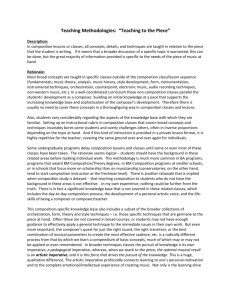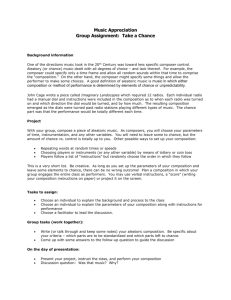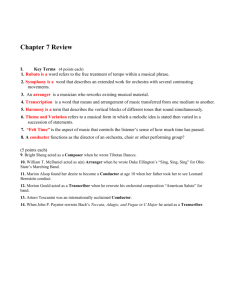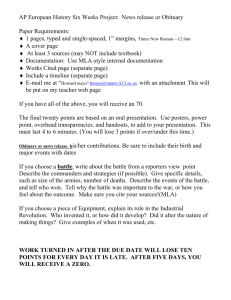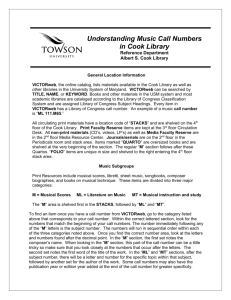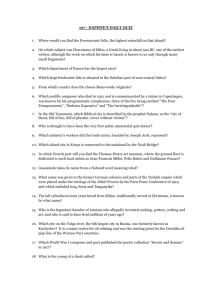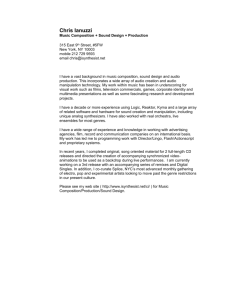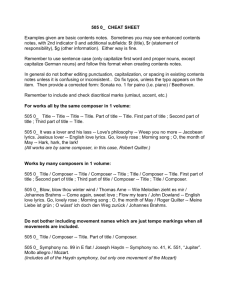Presenting a programme - Federation of Recorded Music Societies
advertisement
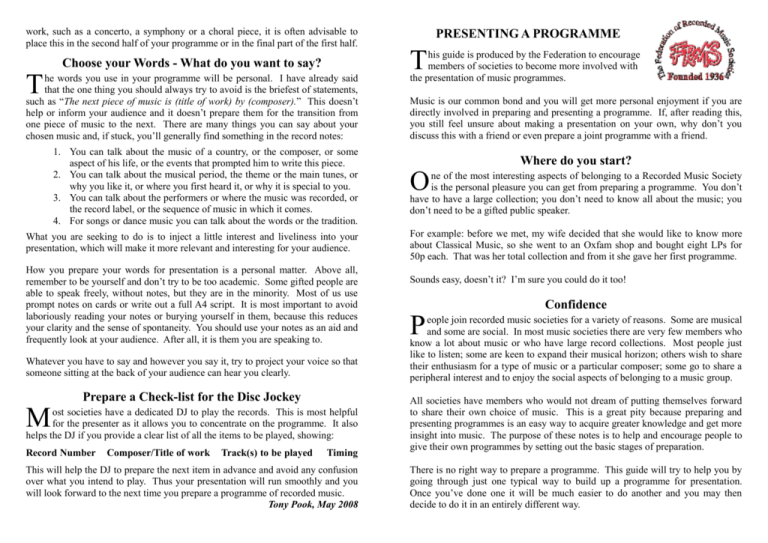
work, such as a concerto, a symphony or a choral piece, it is often advisable to place this in the second half of your programme or in the final part of the first half. Choose your Words - What do you want to say? T he words you use in your programme will be personal. I have already said that the one thing you should always try to avoid is the briefest of statements, such as “The next piece of music is (title of work) by (composer).” This doesn’t help or inform your audience and it doesn’t prepare them for the transition from one piece of music to the next. There are many things you can say about your chosen music and, if stuck, you’ll generally find something in the record notes: 1. You can talk about the music of a country, or the composer, or some aspect of his life, or the events that prompted him to write this piece. 2. You can talk about the musical period, the theme or the main tunes, or why you like it, or where you first heard it, or why it is special to you. 3. You can talk about the performers or where the music was recorded, or the record label, or the sequence of music in which it comes. 4. For songs or dance music you can talk about the words or the tradition. What you are seeking to do is to inject a little interest and liveliness into your presentation, which will make it more relevant and interesting for your audience. How you prepare your words for presentation is a personal matter. Above all, remember to be yourself and don’t try to be too academic. Some gifted people are able to speak freely, without notes, but they are in the minority. Most of us use prompt notes on cards or write out a full A4 script. It is most important to avoid laboriously reading your notes or burying yourself in them, because this reduces your clarity and the sense of spontaneity. You should use your notes as an aid and frequently look at your audience. After all, it is them you are speaking to. Whatever you have to say and however you say it, try to project your voice so that someone sitting at the back of your audience can hear you clearly. Prepare a Check-list for the Disc Jockey M ost societies have a dedicated DJ to play the records. This is most helpful for the presenter as it allows you to concentrate on the programme. It also helps the DJ if you provide a clear list of all the items to be played, showing: Record Number Composer/Title of work Track(s) to be played Timing This will help the DJ to prepare the next item in advance and avoid any confusion over what you intend to play. Thus your presentation will run smoothly and you will look forward to the next time you prepare a programme of recorded music. Tony Pook, May 2008 PRESENTING A PROGRAMME T his guide is produced by the Federation to encourage members of societies to become more involved with the presentation of music programmes. Music is our common bond and you will get more personal enjoyment if you are directly involved in preparing and presenting a programme. If, after reading this, you still feel unsure about making a presentation on your own, why don’t you discuss this with a friend or even prepare a joint programme with a friend. Where do you start? O ne of the most interesting aspects of belonging to a Recorded Music Society is the personal pleasure you can get from preparing a programme. You don’t have to have a large collection; you don’t need to know all about the music; you don’t need to be a gifted public speaker. For example: before we met, my wife decided that she would like to know more about Classical Music, so she went to an Oxfam shop and bought eight LPs for 50p each. That was her total collection and from it she gave her first programme. Sounds easy, doesn’t it? I’m sure you could do it too! Confidence P eople join recorded music societies for a variety of reasons. Some are musical and some are social. In most music societies there are very few members who know a lot about music or who have large record collections. Most people just like to listen; some are keen to expand their musical horizon; others wish to share their enthusiasm for a type of music or a particular composer; some go to share a peripheral interest and to enjoy the social aspects of belonging to a music group. All societies have members who would not dream of putting themselves forward to share their own choice of music. This is a great pity because preparing and presenting programmes is an easy way to acquire greater knowledge and get more insight into music. The purpose of these notes is to help and encourage people to give their own programmes by setting out the basic stages of preparation. There is no right way to prepare a programme. This guide will try to help you by going through just one typical way to build up a programme for presentation. Once you’ve done one it will be much easier to do another and you may then decide to do it in an entirely different way. The Stages of Preparation F or the purposes of illustration we will do things in a pre-determined order, which will help to ensure that we don’t forget anything. The stages are: 1. Choose a subject 2. Choose the music 3. Check the Timing, Sequence and Balance 4. Choose your words 5. Prepare a check-list for the DJ This is not the only way to prepare a programme but it is a useful starting point to guide us through the main stages of preparation. Choose a subject A programme does not need to have a subject or a theme but it does help if you have some idea of what you intend to do and why. Your subject can be as broad as, for example, My Favourite Music or My Desert Island Discs; it can be as generalised as Autumn or The Oceans; or it can be as specialised as Beethoven: The Final Quartets or Great Singers of the Twentieth Century. In all cases the subject or theme will serve the same purpose - it will give you a basic framework on which to construct your presentation. It will also be a great help later, when you are looking for words to say, because it will give you something interesting to talk about. Choose the Music B y now, having thought of a subject, you will have one or two ideas of what you would like to play. Choose a number of records, preferably more than you could possibly play within one programme, and listen to them. It is always helpful to play through your chosen music because this will confirm to you that: 1. 2. These really are the pieces you want to play, and They will be interesting to your potential audience. It may be that at this time you will play some works that you haven’t heard before. By listening to and exploring this music you will become more familiar with its themes and tunes and therefore you will recognise it more easily and increase your personal enjoyment. The notes accompanying your record or CD provide a very good source of material for your introductory comments. Just by reading these notes you will begin to learn about both the composer and the music. You may even look for further information in reference books or on the Internet. It is a very rare piece of music that does not have something written about it on the web. Check the Timing, Sequence and Balance I t is most important to know how much time you have available for your programme and to be aware of any constraints that apply to your Society: 1. What time do your programmes start; 2. What time is the Interval and how long is it - do the members who prepare refreshments require a prompt ten minutes before the interval; 3. What time do you need to stop playing music (remember that there will be administrative notices and that the equipment has to be put away). This will give you the overall TIME available for your programme. In a typical society, the evening might start at 7.30 and finish at 9.30 or 9.45, with a twentyminute break for refreshments and a further five-to-ten minutes for administration. This would give you a total time of between 90 and 105 minutes for your programme. You have now to divide this time between playing music and talking. Let us assume that you have 90 minutes available and that you have chosen six pieces of music. If you are a beginner you may not have too much to say between records but whatever you do you should say more than “The next record is a song by Richard Straus”. That doesn’t give the DJ time to change the record and it is not very interesting for your audience. You should try to spend at least two-tothree minutes to introduce each piece of music; say something about the work, the composer, the artist or why you like it. Thus twelve to eighteen minutes are required for talking, leaving you with some 72 to 78 minutes for music. It is at this point that you might want to revise what you are going to play. You may decide not to play one piece, or to omit a movement from a long work, or to change a piece for something shorter. Whatever you do, you should ensure that you do not exceed the allowed time. It is better to finish early rather than to overrun. (Some societies have flexibility in their finishing times, in which case you too will have flexibility). Now you have to choose the SEQUENCE in which the music will be played and, from this, ensure that you have a reasonable BALANCE within your programme. In sequencing the music you should try and vary the mood and tempo between different pieces: try and alternate fast and slow music, short and long pieces, vocal and orchestral works. This will all help to give your programme balance and the variation between pieces will maintain the interest of your listeners. Try to start with something not too long that will gain your audience’s attention. It may be a piece that they already know, or a lively overture. If you have a major
